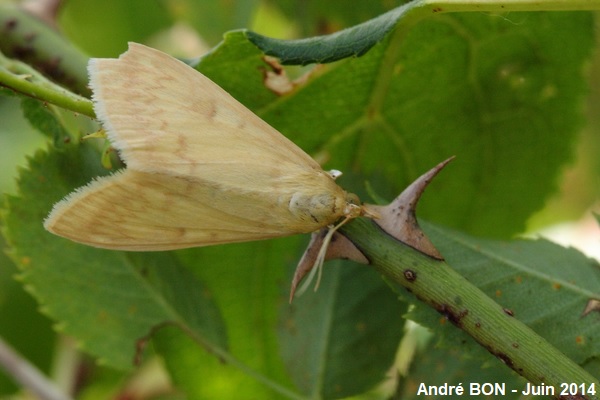



| European Corn Borer (Ostrinia nubilalis (Hübner, 1796)) |




|
|
Scientific name: Ostrinia nubilalis (Hübner, 1796) Common name: European Corn Borer French name: Pyrale du maïs Order: Lepidoptera Suborder: Heterocera Family: Crambidae Subfamily: Pyraustinae Wingspan: 20 to 26 mm for males, 25 to 34 mm for females Biotope: Areas where the host plants are cultivated. Geographic area: Europe, south-western Asia. Introduced to North America to the United States and to Canada. Flight time: Late June to late July. Mid-June to Mid-August in the Mediterranean regions where there are two broods per year. Number of generations : 1 generation in the northern part of the range, 2 in the southern part. Caterpillar: Greyish yellow with a dark head. Each segment shows six small plates with one hair on each one. Host plant: Corn (Zea mays), Common Hop (Humulus lupulus), Raspberry (Rubus strigosus), Peppers (Capsicum annuum) and Sword lilies (Gladiolus sp). |
Female European Corn Borers have pale yellow to pale brown fore wings with thin brown zigzag-shaped cross lines. The greyish white hind wings are also crossed by darker zigzag-shaped lines. Males are a darker colour, ochre to dark brown. The median area and the submarginal area are generally darker. You can better see the zigzag-shaped cross lines bordering these areas. When European Corn Borers are landed with their wings closed, the last segments of the males' abdomen protrude beyond the wing margins. This is not the case with females. There is a possible confusion of females with Lesser Pearls (Sitochroa verticalis). This last species shows dark grid-like patterns on the underside of the wings. You can also use the markings on the upper side of the wings to tell both species apart. The post median line is irregularly wavy with sharp saw-teeth on the European corn Borer. This line is straighter and rather scalloped on Sitochroa verticalis. On the European Corn Borer species, the reniform spot is delimited by a darker dot on the basal side and by a darker arch-shaped marking on the marginal side. This spot is delimited by more diffused patches on Sitochroa verticalis. |
| [To know more about the European Corn Borer] [Next picture] [Top] |

|
I have observed this European Corn Borer next to a cultivated area where corn was growing. The observation date, that's to say mid-June, may indicate that this one is of the bivoltine subspecies with two generations per year. |
| [To know more about the European Corn Borer] [Next picture] [Previous picture] [Top] |

|
The rather dark colour and the abdomen protruding beyond the closed wings indicate one male. |
| [To know more about the European Corn Borer] [Next picture] [Previous picture] [Top] |

|
I first thought that this one was Sitochroa verticalis. But the sharp serrated teeth of the postmedian line and the markings on each side of the reniform spot clearly indicate the Corn Borer species. |
| [To know more about the European Corn Borer] [Previous picture] [Top] |

|
Same specimen as above. The pale colour and the abdomen not protruding beyond the wing margin indicate one female. |